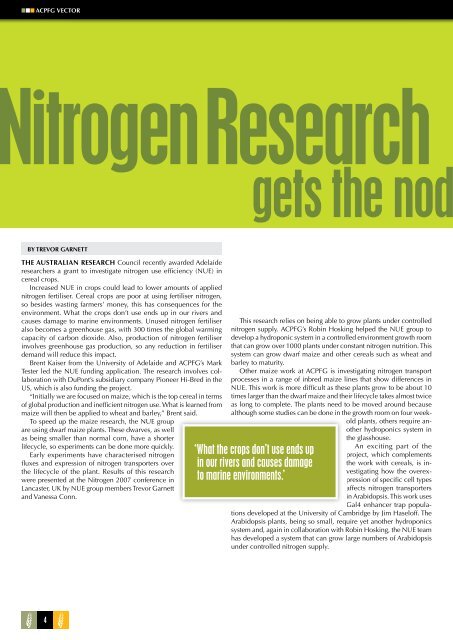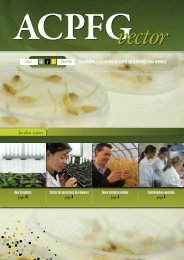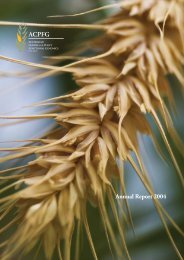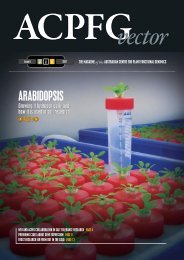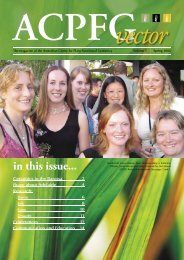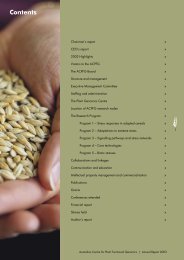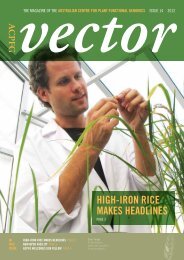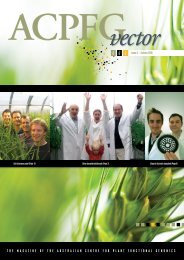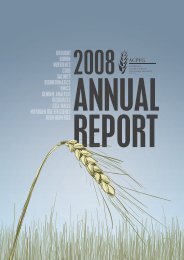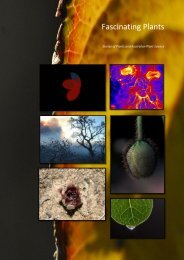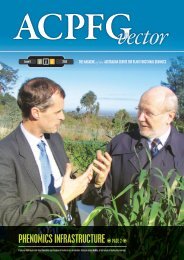Issue 7 2008 - acpfg
Issue 7 2008 - acpfg
Issue 7 2008 - acpfg
- No tags were found...
You also want an ePaper? Increase the reach of your titles
YUMPU automatically turns print PDFs into web optimized ePapers that Google loves.
ACPFG VECTORitrogen Researchgets the nodBY TREVOR GARNETTTHE AUSTRALIAN RESEARCH Council recently awarded Adelaideresearchers a grant to investigate nitrogen use efficiency (NUE) incereal crops.Increased NUE in crops could lead to lower amounts of appliednitrogen fertiliser. Cereal crops are poor at using fertiliser nitrogen,so besides wasting farmers’ money, this has consequences for theenvironment. What the crops don’t use ends up in our rivers andcauses damage to marine environments. Unused nitrogen fertiliseralso becomes a greenhouse gas, with 300 times the global warmingcapacity of carbon dioxide. Also, production of nitrogen fertiliserinvolves greenhouse gas production, so any reduction in fertiliserdemand will reduce this impact.Brent Kaiser from the University of Adelaide and ACPFG’s MarkTester led the NUE funding application. The research involves collaborationwith DuPont’s subsidiary company Pioneer Hi-Bred in theUS, which is also funding the project.“Initially we are focused on maize, which is the top cereal in termsof global production and inefficient nitrogen use. What is learned frommaize will then be applied to wheat and barley,” Brent said.To speed up the maize research, the NUE groupare using dwarf maize plants. These dwarves, as wellas being smaller than normal corn, have a shorterlifecycle, so experiments can be done more quickly.Early experiments have characterised nitrogenfluxes and expression of nitrogen transporters overthe lifecycle of the plant. Results of this researchwere presented at the Nitrogen 2007 conference inLancaster, UK by NUE group members Trevor Garnettand Vanessa Conn.This research relies on being able to grow plants under controllednitrogen supply. ACPFG’s Robin Hosking helped the NUE group todevelop a hydroponic system in a controlled environment growth roomthat can grow over 1000 plants under constant nitrogen nutrition. Thissystem can grow dwarf maize and other cereals such as wheat andbarley to maturity.Other maize work at ACPFG is investigating nitrogen transportprocesses in a range of inbred maize lines that show differences inNUE. This work is more difficult as these plants grow to be about 10times larger than the dwarf maize and their lifecycle takes almost twiceas long to complete. The plants need to be moved around becausealthough some studies can be done in the growth room on four week-old plants, others require anotherhydroponics system inthe glasshouse.An exciting part of theproject, which complementsthe work with cereals, is investigatinghow the overexpressionof specific cell typesaffects nitrogen transportersin Arabidopsis. This work usesGal4 enhancer trap tions developed at the University of Cambridge by Jim Haseloff. Thepopula-Arabidopsis plants, being so small, require yet another hydroponicssystem and, again in collaboration with Robin Hosking, the NUE teamhas developed a system that can grow large numbers of Arabidopsisunder controlled nitrogen supply.‘What the crops don’t use ends upin our rivers and causes damageto marine environments.’4


